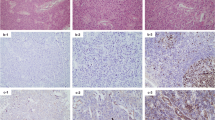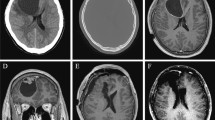Abstract
Ependymomas are primary neuroepithelial malignancies that mainly occur during childhood, and arise from ependymal cells along the ventricular systems of the CNS. Recently, it was elucidated that two-thirds of supratentorial (ST) ependymomas harbor oncogenic fusions of RELA, whose protein product is the principal effector of canonical NF-κB signaling. RELA fusion proteins activate signaling for tumor proliferation and malignant progression, resulting in poorer prognoses in these patients compared to those in patients with other ST ependymomas. In this study, we encountered a case of C11orf–RelA fusion-positive ST anaplastic ependymoma that was diagnosed in first tumor resection surgery of multi-staged gross total resection with molecular evidence. In ependymomas, regardless of tumor location or pathological grade, subtotal resection is associated with higher rates of mortality compared with GTR. Molecular analysis based on the application of recent molecular knowledge for ST ependymomas performs a role in appropriate and individualized treatment strategies.



Similar content being viewed by others
References
Louis DN, Ohgaki H, Wiestler OD et al (2016) WHO classification of tumours of the central nervous system. IARC Publications, Lyon
Nazar GB, Hoffman HJ, Becker LE et al (1990) Infratentorial ependymomas in childhood: prognostic factors and treatment. J Neurosurg 72:408–417
Parker M, Mohankumar KM, Punchihewa C et al (2014) C11orf95–RELA fusions drive oncogenic NF-kappaB signalling in ependymoma. Nature 506:451–455
Pietsch T, Wohlers I, Goschzik T et al (2014) Supratentorial ependymomas of childhood carry C11orf95–RELA fusions leading to pathological activation of the NF-kappaB signaling pathway. Acta Neuropathol 127:609–611
Mack SC, Witt H, Piro RM et al (2014) Epigenomic alterations define lethal CIMP-positive ependymomas of infancy. Nature 506:445–450
Pajtler KW, Witt H, Sill M et al (2015) Molecular classification of ependymal tumors across all CNS compartments, histopathological grades, and age groups. Cancer Cell 27:728–743
Sturm D, Orr BA, Toprak UH et al (2016) New brain tumor entities emerge from molecular classification of CNS-PNETs. Cell 164:1060–1072
Merchant TE, Li C, Xiong X et al (2009) Conformal radiotherapy after surgery for paediatric ependymoma: a prospective study. Lancet Oncol 10:258–266
Cage TA, Clark AJ, Aranda D et al (2013) A systematic review of treatment outcomes in pediatric patients with intracranial ependymomas. J Neurosurg Pediatr 11:673–681
Massimino M, Solero CL, Garre ML et al (2011) Second-look surgery for ependymoma: the Italian experience. J Neurosurg Pediatr 8:246–250
Cartmill M, Hewitt M, Walker D et al (2001) The use of chemotherapy to facilitate surgical resection in pleomorphic xanthoastrocytoma: experience in a single case. Child’s Nerv Syst 17:563–566
Valera ET, Serafini LN, Machado HR, Tone LG (2003) Complete surgical resection in children with low-grade astrocytomas after neoadjuvant chemotherapy. Child’s Nerv Syst 19:86–90
Valera ET, Machado HR, Santos AC et al (2005) The use of neoadjuvant chemotherapy to achieve complete surgical resection in recurring supratentorial anaplastic ependymoma. Child’s Nerv Syst 21:230–233
Huang J, Barbera L, Brouwers M et al (2003) Does delay in starting treatment affect the outcomes of radiotherapy? A systematic review. J Clin Oncol 21:555–563
van den Bent MJ, Afra D, de Witte O et al (2005) Long-term efficacy of early versus delayed radiotherapy for low-grade astrocytoma and oligodendroglioma in adults: the EORTC 22845 randomised trial. Lancet 366:985–990
Acknowledgements
This work is dedicated to the memory of Professor Nobutaka Kawahara.
Author information
Authors and Affiliations
Corresponding author
Rights and permissions
About this article
Cite this article
Nakamura, T., Fukuoka, K., Ikeda, J. et al. Encouraging option of multi-staged gross total resection for a C11orf-RelA fusion-positive supratentorial anaplastic ependymoma. Brain Tumor Pathol 34, 160–164 (2017). https://doi.org/10.1007/s10014-017-0297-5
Received:
Accepted:
Published:
Issue Date:
DOI: https://doi.org/10.1007/s10014-017-0297-5




